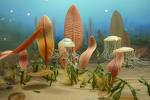 |
 |
 |
 |
 |
Produced
by the Population Genetics and Evolution class, Furman University |
||||
 |
 |
 |
 |
 |
Produced
by the Population Genetics and Evolution class, Furman University |
||||
 |
The
Ediacaran: Cyclomedusa |
 |
Cyclomedusa
is on of the most prevalent Ediacaran fossils of the Vendian period
(UCMP 2009). Cyclomedusa is characterized as a radial fossil
with a circular raised area in the center, with as many as five concentric
growth ridges surrounding it (Wikipedia 2009). These circular ridges
are thought to be folds of the outer layer, or internal tissues such
as muscles (Nedin 1999). Cyclomedusa was once thought to be
a planktonic jellyfish, however, since these fossils are found covered
by sand, it has been concluded that these organisms were actually benthic
polyps similar to sea anemones and were anchored to the sea floor instead
of swimming in the water column (Clowes 2004). It has also been hypothesized
that these organisms could have been microbial colonies (The Virtual
Fossil Museum 2002). Currently, Cyclomedusa has no known relatives
(Wikipedia 2009). There are however, a four known of species of Cyclomedusa:
C. plana, C. radiata, C. gigantea, and C. davidi (Clowes
2004). These fossils are found in a variety of sizes ranging from a
few millimeters to a meter in diameter (Clowes 2004). Specimens have
been found around the world ranging from the White Sea in Russia to
China, England, Canada, and Mexico (The Virtual Fossil Museum 2002).
These fossilized eukaryotes have been found in sediments dating back
to roughly 600 million years ago and are used currently in intensive
research to further improve the fossil record (The Virtual Fossil Museum
2002). Page by Chapin Hardy |
 |
| Cyclomedusa sp.Photo credit: UCMP |
|
|
Nedin, C. 1999. Cyclomedusa davidi. Accessed January 21, 2010. Clowes, C. 2004. The Ediacaran (Vendian)-3. www.paleos.com. Accessed January 25, 2010. University of California Museum of Paleontology (UCMP). Vendian Animals: Cyclomedusa. Accessed January 21, 2010. The Virtual Fossil Museum. 2002. Ediacaran Fossils of the Vendian White Sea Summer Coast, Northern Russia. Accessed January 25, Wikipedia. 2010.Cyclomedusa. Accessed January 25, 2010 |